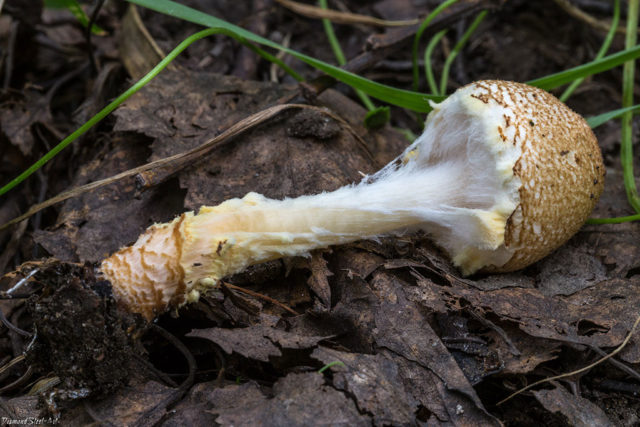Content
Lepiota corypus is a little-known mushroom of the Champignon family, genus Lepiota. It is distinguished by its small size and scaly cap. Another name is small-thyroid/thyroid umbrella.
What do Lepiotis scutes look like?
The young specimen has a blunt bell-shaped cap and a cotton wool-like cover consisting of small, woolly scales on its whitish surface. In the center, a smooth, detachable tubercle of a darker color - brown or brown - is clearly visible.As it grows, the cap becomes spread out, the scales become ocher-brown or reddish-brown, standing out sharply against the background of the whitish flesh, larger towards the middle. Along the edge there is an edge hanging down in the form of small flaps from the remains of the bedspread. The diameter of the cap is from 3 to 8 cm.
The plates are white or cream, frequent, freely spaced, different in length, slightly convex.
The pulp is white, soft, with a fruity aroma and a sweetish taste.
The spore powder is whitish. Spores are medium size, colorless, oval.
The leg is cylindrical, hollow inside, widening towards the base. Equipped with a small soft, flaky, light, quickly disappearing ring. Above the cuff, the leg is white and smooth, covered with yellowish or brownish scales and a flaky whitish coating, brown or rusty at the base. The length of the leg is from 6 to 8 cm, the diameter is from 0.3 to 1 cm.
Where do Lepiotis corypus grow?
Settles in deciduous and mixed forests, on litter or soil rich in humus. The fungus is widespread in the Northern Hemisphere in the temperate climate zone.
Is it possible to eat Lepiotis corypus?
Information about the edibility of the mushroom varies. Some experts classify it as conditionally edible with low taste. Others believe that it is not suitable for human consumption.
Taste qualities of the mushroom lepiota corypus
The thyroid umbrella is little known, quite rare and not popular among mushroom pickers. There is practically no information about its taste.
Benefits and harm to the body
No information available. The mushroom has been little studied.
False doubles
Lepiota scutella and similar species have not been sufficiently studied. It has many similarities with small representatives of its genus, including poisonous ones, and it is not easy to find the difference between them.
- Lepiota chestnut. Inedible poisonous mushroom.Differs in smaller sizes. The diameter of the cap is 1.5-4 cm. In young mushrooms it is ovoid, then it becomes bell-shaped, convex, prostrate and flat. The color is whitish or cream, the edges are uneven, with flakes. In the center there is a dark tubercle, on the surface there are felt scales of a chestnut, brown or brick shade. The plates are frequent, wide, first white, then fawn or yellowish. Leg length – 3-6 cm, diameter – 2-5 mm. Externally, it is almost the same as that of Lepiota scute. The pulp is cream or yellowish, soft, brittle, thin, and has a pronounced and rather pleasant mushroom smell. Most often found along forest roads from July to August.
- Lepiota narrowsporata. They can only be distinguished under a microscope: the spores are smaller and have a different shape. There is no information about edibility.
- Lepiota spores. It is classified as poisonous, but in some sources it is mentioned as an edible mushroom. It is very difficult to distinguish it from other representatives of the genus with the naked eye. One of the signs is severe scaliness of the edge of the cap and stem. Rarely found in small groups in mixed and deciduous forests.
- Lepiota macrospores. Microscopically reliably determined by larger spores. External differences include loose, abundant velum (cover of a young mushroom), giving it a shaggy appearance, pinkish color of the tissue between the scales, and a fleecy annular zone on the stalk without the formation of a cuff. Grows in groups or singly on fertile soils in forests of any type. Can be found from August to October. There is no information about edibility.
- Lepiota erinaceae. The white mushroom grows on litter or soil in pastures, meadows, and lawns. Found within the city limits. The flesh at the break turns red. The diameter of the cap is from 2.5 to 10 cm.The height of the leg is from 5 to 10 cm, the diameter is from 0.3 to 1 cm. It is distinguished by a very light color and size. There is no data on edibility.
Collection rules
Lepiota scutella is rare and grows in small groups of 4-6 pieces. Fruits from mid-summer to September, especially actively from late July to August.
Use
Little is known about the cooking methods. The mushroom is poorly studied and may contain dangerous substances, so it should not be eaten.
Conclusion
Lepiota corymbata is a rare mushroom. It is very similar to its other relatives, and it is practically impossible to distinguish it from many of them with the naked eye, including poisonous ones.















